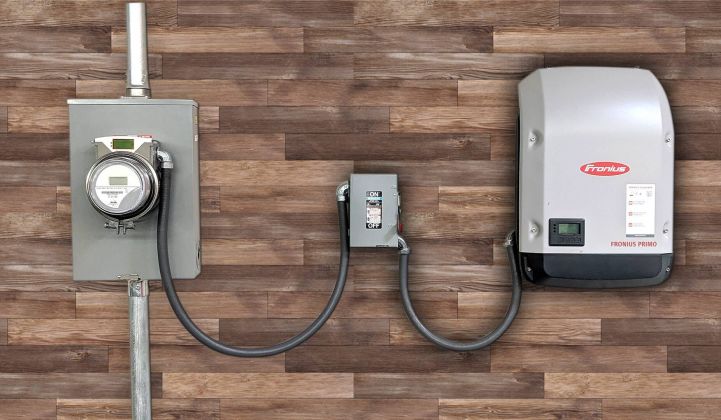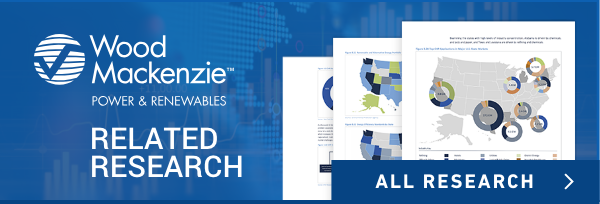Last week, New York utility Con Edison launched its latest effort to smooth the way for customers to install rooftop solar — and to feed the utility's growing hunger for data on how that solar can be integrated into its grid.
The tool it’s using, built by Arlington, Virginia-based company ConnectDER, is a meter collar adapter that plugs into the socket where electrical meters connect to buildings. In its simplest applications, it can provide the data collection and computing power of a typical smart meter, serving as a cellular-connected point solution to connect particular customers to utilities that haven’t yet deployed advanced metering infrastructure across their territories.
But ConnectDER’s devices can also serve as a connection point for rooftop solar systems, allowing installers to avoid costly circuit-breaker panel upgrades and time-consuming wiring work. A 300-unit pilot installation launched in 2017 achieved savings of between $400 and $1,500 per installation, making the $400 upfront cost of the device well worth it for customers, according to James Skillman, Con Edison customer project manager.
The next 2,400 units Con Edison will be installing over the next year and a half will continue those savings, he said. But they’ll also start delivering valuable data as part of a pilot project with the New York State Energy Research and Development Agency (NYSERDA) — precise, real-time measurements of solar generation on distribution circuits that may face disruptions from the utility’s growing share of customer-owned solar.
“We have more than 35,000 customers connected with solar, and those with the ConnectDER products are the only ones we know exactly what they’re doing,” he said. Con Edison is in the final stages of deploying smart meters to its approximately 1.3 million customers, but those only measure net household loads, not what’s happening behind the meter.
The idea of utility-owned technology serving as a control point for customer-owned distributed energy resources (DERs) may well spark suspicion from residential solar and storage providers, which are used to battling with utilities over net metering tariffs, interconnection policies and other aspects of how their systems interact with the power grids they’re connected to.
But being able to differentiate solar production from net load will help Con Edison in planning future grid investments to manage the potential voltage disruptions and two-way power flows that could arise as distributed solar rises as a proportion of its overall electricity supply, Skillman said. That could prove beneficial for the solar industry as well if it leads to easing interconnection limits to adding more solar.
Another pilot project underway with NYSERDA will explore integrating ConnectDER’s solar data into its smart meter wireless mesh network, which could supply data to inform real-time distribution grid operations. And the same benefits could apply to monitoring the behind-the-meter batteries, electric vehicle chargers and other DERs that are set to expand dramatically under New York state’s aggressive decarbonization mandates.
“Using it to install a battery or EV charger is great because that power exits the connector before it hits the customer's internal breaker panel,” said Skillman. “All that power will be measured by the connector itself, and it allows you to do some interesting things,” from crafting rate programs and incentives for batteries and EV chargers to tracking how they can serve to reduce or replace grid investments. "That's where we really get excited from a distribution-engineering standpoint."
A growing need for utility-customer distributed energy connection
As more and more solar installations seek to interconnect to the grid, finding ways to share data with utilities — or even offer them some control over how they operate — could end up helping DERs grow to scale, ConnectDER CEO Whit Fulton said in an interview.
ConnectDER isn’t the only way for utilities to get visibility into behind-the-meter DERs. Energy disaggregation technologies can analyze power flows to estimate major loads. The latest versions of smart electrical panels or home energy management systems being built by industry heavyweights like Schneider Electric and Eaton and startups such as Span and Lumin can provide actual circuit-level data and control.
New solar and battery inverters can also communicate vital operational data via standard protocols, a capability that’s been tapped by utilities in pilot projects across the country. And companies including Tesla, Sunrun, sonnen, Generac and Swell are aggregating solar- and battery-equipped homes to provide grid services as virtual power plants.
But utilities aren’t in charge of these devices and can’t guarantee access to their data, Fulton noted. Even when vendors are making their data available, “it’s forcing a lot of complexity on the utility to interface with the DER market in a comprehensive way.”
“At the same time, utilities are under pressure from regulators and from legislatures” in states such as New York that have set goals for tapping the value of customer-owned DERs, he said. “We’re allowing a utility to offer faster, better, more secure options for connecting to the utility.”
In fact, ConnectDER’s meter socket devices are already in use by a utility behind one of the country’s first and largest virtual power plant projects, he said. ConnectDER devices are in use by Vermont utility Green Mountain Power to ease interconnection challenges for solar and battery installations. GMP offers customers upfront payments or monthly lease plans for utility-owned or third-party-supplied batteries, plus EV chargers and smart thermostats and water heaters, in exchange for making them available for grid needs.
Likewise, utility Arizona Public Service has used ConnectDER to link customers’ solar inverters to utility communications networks as part of its wide-ranging distributed energy integration programs, and Hawaiian Electric has made them available to customers to manage the tariffs that have replaced solar net metering.
To be sure, solar installers are leery of utilities being able to take control of customer solar systems. But there could be upsides to solar industry growth to allowing it, Fulton said.
Specifically, he pointed to a pilot project underway at Pennsylvania utility PPL Electric, where ConnectDER’s meter collars are being used to run head-to-head tests of how automated smart inverter settings compare to active utility control of rooftop solar systems for managing grid disruptions.
While solar installers have largely resisted utility proposals to control solar systems, it’s possible that reducing their output during certain moments of the day could actually increase the hosting capacity of solar-saturated circuits, allowing more solar to be installed.
“We’re really excited about that one,” he said. “It’s going to be a transparent auditing of the value of direct utility control versus autonomous or independent settings."




